Implementation of Nitration Processes in Artificial Ageing for Closer-to-Reality Simulation of Engine Oil Degradation
Abstract
1. Introduction
2. Materials and Methods
2.1. Definition of Target Oil Condition
2.2. Engine Oil Selection
2.3. Oil Alteration
2.4. Heat Treatment
2.5. Oil Condition Monitoring
2.5.1. Conventional Oil Analysis
2.5.2. Advanced Oil Analysis by High-Resolution Mass Spectrometry
- Instrument: LTQ Orbitrap XL hybrid tandem high-resolution mass spectrometer (ThermoFisher Scientific, Bremen, Germany).
- Software: Xcalibur version 2.0.7 and Mass Frontier version 8.0 (ThermoFisher Scientific, Bremen, Germany).
- Source voltage: 3.80 kV,
- Capillary voltage: −35 V,
- Sheath gas flow rate: 55 arb (nitrogen),
- Spray capillary temperature: 275 °C.
3. Results and Discussion
3.1. Progress of Alteration Monitored by Conventional Analysis
3.2. Comparison with the Target Oil Condition
3.2.1. Conventional Parameters
3.2.2. Advanced Oil Analysis by High-Resolution Mass Spectrometry
3.3. Heat Treatment and Depletion of Nitration Products
4. Conclusions
Author Contributions
Funding
Institutional Review Board Statement
Informed Consent Statement
Data Availability Statement
Conflicts of Interest
References
- Forschung & Lehre: Geht das Zeitalter des Autos zu Ende? Available online: https://www.forschung-und-lehre.de/zeitfragen/geht-das-zeitalter-des-autos-zu-ende-1831 (accessed on 12 July 2022).
- European Automobile Manufacturers’ Association (ACEA): ACEA Report–Vehicles in Use–Europe 2022. Available online: https://www.acea.auto/files/ACEA-report-vehicles-in-use-europe-2022.pdf (accessed on 12 July 2022).
- European Comission: Emissions in the Automotive Sector. Available online: https://ec.europa.eu/growth/sectors/automotive-industry/environmental-protection/emissions-automotive-sector_en (accessed on 12 July 2022).
- Dörr, N.; Agocs, A.; Besser, C.; Ristic, A.; Frauscher, M. Engine Oils in the Field: A Comprehensive Chemical Assessment of Engine Oil Degradation in a Passenger Car. Trib. Lett. 2019, 67, 68. [Google Scholar] [CrossRef]
- Nagy, A.L.; Agocs, A.; Ronai, B.; Raffai, P.; Rohde-Brandenburger, J.; Besser, C.; Dörr, N. Rapid Fleet Condition Analysis through Correlating Basic Vehicle Tracking Data with Engine Oil FT-IR Spectra. Lubricants 2021, 9, 114. [Google Scholar] [CrossRef]
- Agocs, A.; Nagy, A.L.; Tabakov, Z.; Perger, J.; Rohde-Brandenburger, J.; Schandl, M.; Besser, C.; Dörr, N. Comprehensive assessment of oil degradation patterns in petrol and diesel engines observed in a field test with passenger cars–Conventional oil analysis and fuel dilution. Tribol. Int. 2021, 161, 107079. [Google Scholar] [CrossRef]
- Sejkorova, M.; Hurtova, I.; Jilek, P.; Novak, M.; Voltr, O. Study of the Effect of Physicochemical Degradation and Contamination of Motor Oils on Their Lubricity. Coatings 2021, 11, 60. [Google Scholar] [CrossRef]
- Wei, L.; Chen, S.; Sun, X.; Jin, Y.; Jia, D.; Li, J.; Duan, H. Study on comprehensive degradation stability of special and nonspecific motor oils. Lubr. Sci. 2021, 33, 92–99. [Google Scholar] [CrossRef]
- Mang, T.; Dresel, W. Lubricants and Lubrication, 2nd ed.; Wiley-VCH Verlag GmbH & Co. KGaA: Weinheim, Germany, 2007. [Google Scholar]
- Besser, C.; Agocs, A.; Ronai, B.; Ristic, A.; Repka, M.; Jankes, E.; McAleese, C.; Dörr, N. Generation of engine oils with defined degree of degradation by means of a large scale artificial alteration method. Tribol. Int. 2019, 132, 39–49. [Google Scholar] [CrossRef]
- Frauscher, M.; Agocs, A.; Besser, C.; Rögner, A.; Allmaier, G.; Dörr, N. Time-Resolved Quantification of Phenolic Antioxidants and Oxidation Products in a Model Fuel by GC-EI-MS/MS. Energy Fuels 2020, 34, 2674–2682. [Google Scholar] [CrossRef]
- Frauscher, M.; Besser, C.; Dörr, N.; Allmaier, G. Oxidation products of ester-based oils with and without antioxidant identified by stable isotope labelling and mass spectrometry. Appl. Sci. 2017, 7, 396. [Google Scholar] [CrossRef]
- Frauscher, M.; Besser, C.; Allmaier, G.; Dörr, N. Elucidation of oxidation and degradation products of oxygen containing fuel components by combined use of a stable isotopic tracer and mass spectrometry. Anal. Chim. Acta 2017, 993, 47–54. [Google Scholar] [CrossRef] [PubMed]
- Kral, J., Jr.; Konecny, B.; Kral, J.; Madac, K.; Fedorko, G.; Molnar, V. Degradation and chemical change of longlife oils following intensive use in automobile engines. Measurement 2014, 50, 34–42. [Google Scholar] [CrossRef]
- Shinde, H.M.; Bewoor, A.K. Evaluating petrol engine oil deterioration through oxidation and nitration parameters by low-cost IR sensor. Appl. Petrochem. Res. 2022, 10, 83–94. [Google Scholar] [CrossRef]
- Eralytics GmbH: Used-Oil Analysis Using a Portable FTIR Spectrometer. Available online: https://eralytics.com/wp-content/uploads/ERASPEC-OIL-article-PIN.pdf (accessed on 12 July 2022).
- DIN 51453; Testing of Lubricants–Determination of Oxidation and Nitration of Used Motor Oils–Infrared Spectrometric Method. Deutsches Institut für Normung: Berlin, Germany, 2004.
- ASTM E 2412; Standard Practice For Condition Monitoring Of Used Lubricants By Trend Analysis Using Fourier Transform Infrared (FT-IR) Spectrometry. ASTM International: West Conshohocken, PA, USA, 2018.
- Agocs, A.; Budnyk, S.; Frauscher, M.; Ronai, B.; Besser, C.; Dörr, N. Comparing oil condition in diesel and gasoline engines. Ind. Lubr. Tribol. 2020, 72, 1033–1039. [Google Scholar] [CrossRef]
- Agocs, A.; Budnyk, S.; Besser, C.; Ristic, A.; Frauscher, M.; Ronai, B.; Dörr, N. Production of Used Engine Oils with Defined Degree of Degradation in a Large-scale Device: Correlation of Artificially Altered Oils with Field Samples. ACTA Tech. Jaurinensis 2020, 13, 131–150. [Google Scholar] [CrossRef]
- CEC L-48-A00; Oxidation Stability of Lubricating Oils Used in Automotive Transmissions by Artificial Ageing. Co-Ordinating European Council for the Development of Performance Tests for Fuels, Lubricants and other Fluids: Brussels, Belgium, 2014.
- ASTM D 6186; Standard Test Method for Oxidation Induction Time of Lubricating Oils by Pressure Differential Scanning Calorimetry (PDSC). ASTM International: West Conshohocken, PA, USA, 2013.
- ASTM D 943; Standard Test Method for Oxidation Characteristics of Inhibited Mineral Oils. ASTM International: West Conshohocken, PA, USA, 2017.
- ASTM D 2272; Standard Test Method for Oxidation Stability of Steam Turbine Oils by Rotating Pressure Vessel. ASTM International: West Conshohocken, PA, USA, 2014.
- Nagy, A.L.; Rohde-Brandenburger, J.; Zsoldos, I. Artificial Aging Experiments of Neat and Contaminated Engine Oil Samples. Lubricants 2021, 9, 63. [Google Scholar] [CrossRef]
- Motamen Salehi, F.; Morina, A.; Neville, A. The effect of soot and diesel contamination on wear and friction of engine oil pump. Tribol. Int. 2017, 115, 285–296. [Google Scholar] [CrossRef]
- Besser, C.; Schneidhofer, C.; Dörr, N.; Novotny-Farkas, F.; Allmaier, G. Investigation of long-term engine oil performance using lab-based artificial ageing illustrated by the impact of ethanol as fuel component. Tribol. Int. 2012, 46, 174–182. [Google Scholar] [CrossRef]
- Besser, C.; Dörr, N.; Novotny-Farkas, F.; Varmuza, K.; Allmaier, G. Comparison of engine oil degradation observed in laboratory alteration and in the engine by chemometric data evaluation. Tribol. Int. 2013, 65, 37–47. [Google Scholar] [CrossRef]
- DIN ISO 6618:2015–07; Petroleum Products and Lubricants–Determination of Acid or Base Number–Colour-Indicator Titration Method. Deutsches Institut für Normung: Berlin, Germany, 2015.
- DIN ISO 3771:1985–04; Petroleum Products; Total Base Number; Perchloric Acid Potentiometric Titration Method. Deutsches Institut für Normung: Berlin, Germany, 1985.
- ASTM D 7042; Standard Test Method for Dynamic Viscosity and Density of Liquids by Stabinger Viscometer (and the Calculation of Kinematic Viscosity). ASTM International: West Conshohocken, PA, USA, 2016.
- ASTM D 2270; Standard Practice for Calculating Viscosity Index from Kinematic Viscosity at 40 °C and 100 °C. ASTM International: West Conshohocken: PA, USA, 2016.
- Gatto, V.J.; Moehle, W.E.; Cobb, T.W.; Schneller, E.R. Oxidation fundamentals and its application to turbine oil testing. J. ASTM Int. 2006, 3, 1–20. [Google Scholar] [CrossRef]
- Soleimani, M.; Dehabadi, L.; Wilson, L.D.; Tabil, L.G. Antioxidants Classification and Applications in Lubricants. In Tribology, Lubricants and Additives; Johnson, D., Ed.; InTechOpen: London, UK, 2018; pp. 23–42. [Google Scholar]
- Kassler, A.; Pittenauer, E.; Dörr, N.; Allmaier, G. Development of an accelerated artificial ageing method for the characterization of degradation products of antioxidants in lubricants by mass spectrometry. Eur. J. Mass Spectrom. 2019, 25, 300–323. [Google Scholar] [CrossRef] [PubMed]
- Agiral, A.; Zalatan, D.; Sutor, P. Understanding total base number measurement. In Proceedings of the STLE 73th Annual Meeting & Exhibition, Minneapolis, MN, USA, 20–24 May 2018. [Google Scholar] [CrossRef]
- SAE J300; Engine Oil Viscosity Classification. SAE International: Warrendale, PA, USA, 2021.

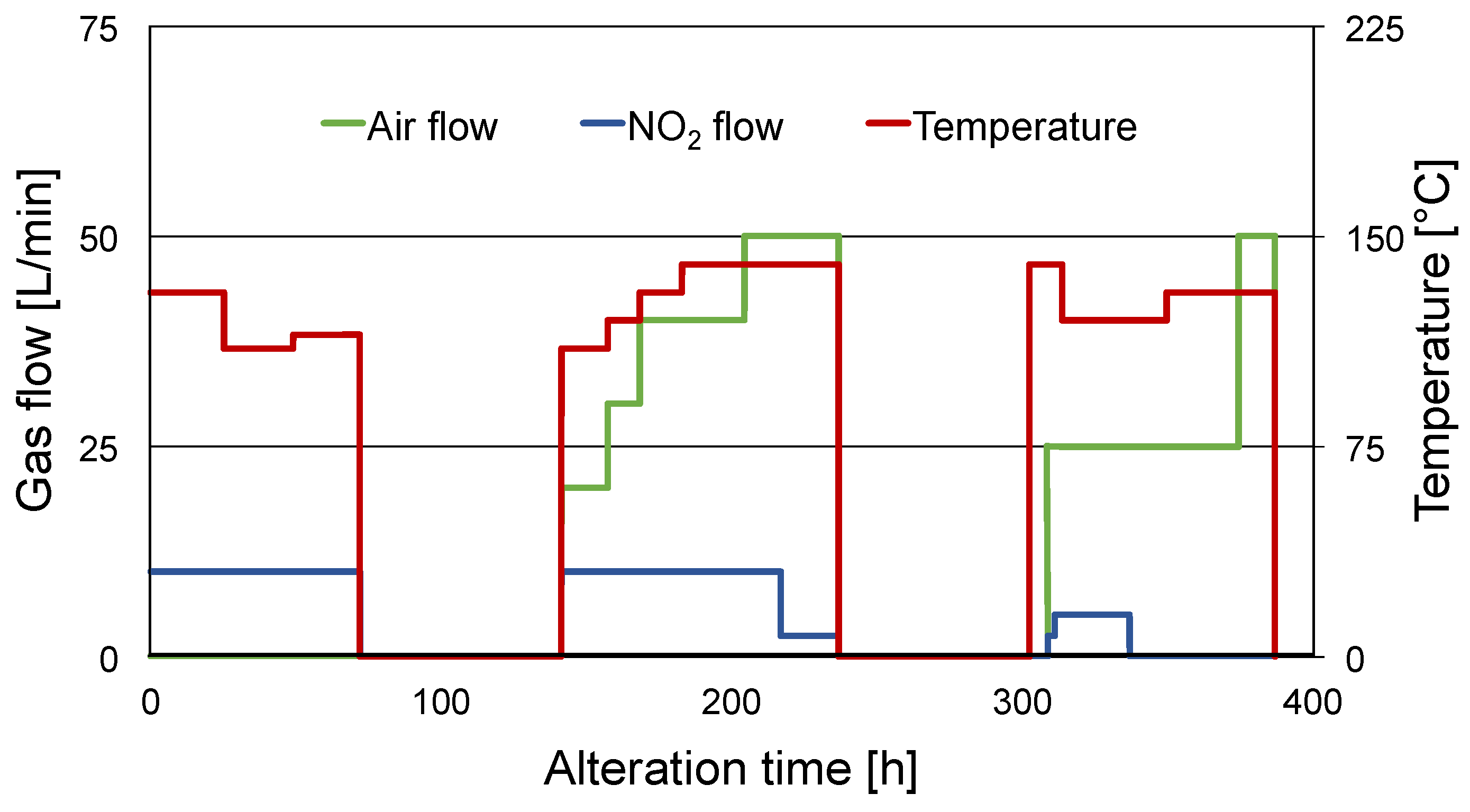



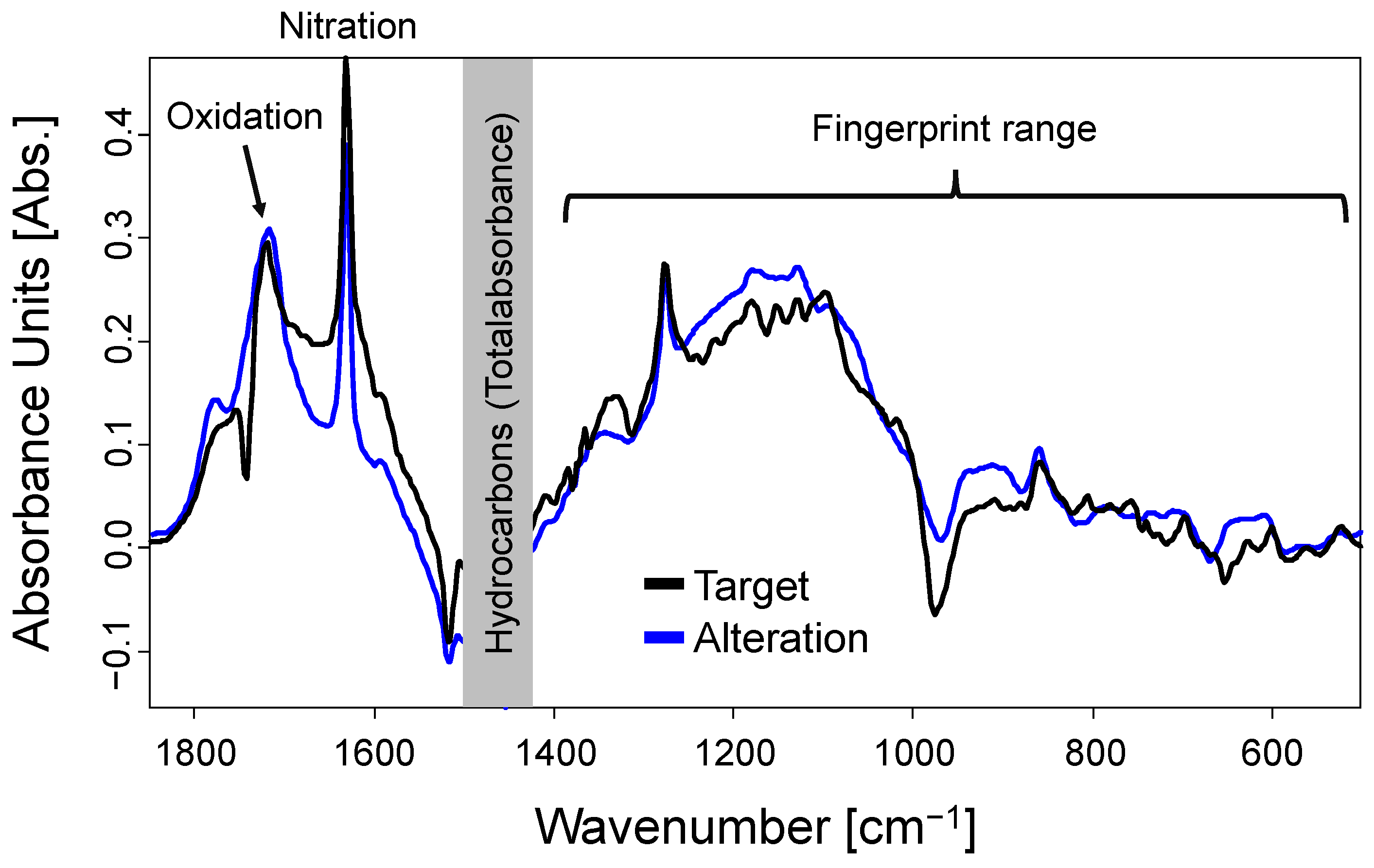
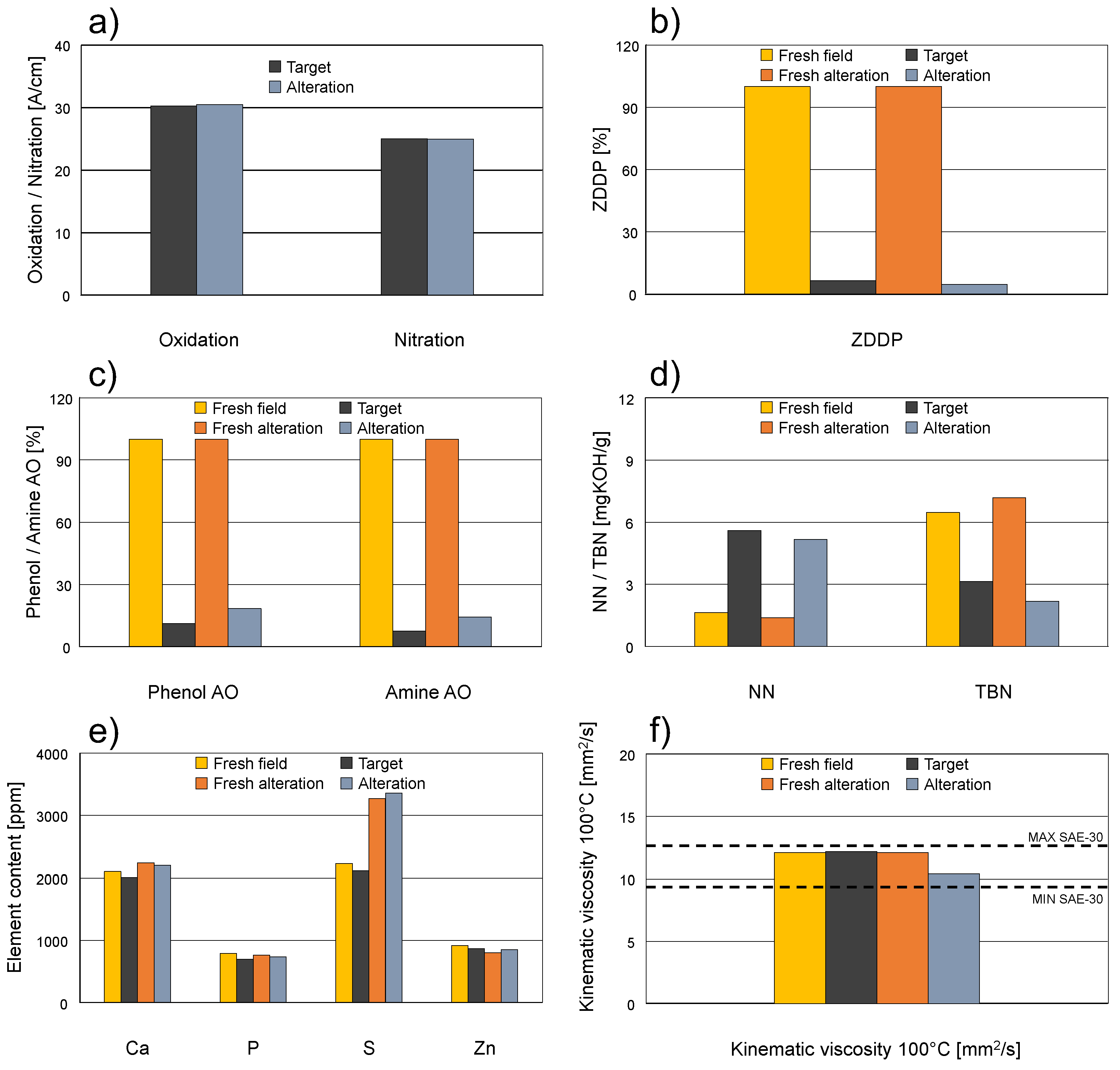
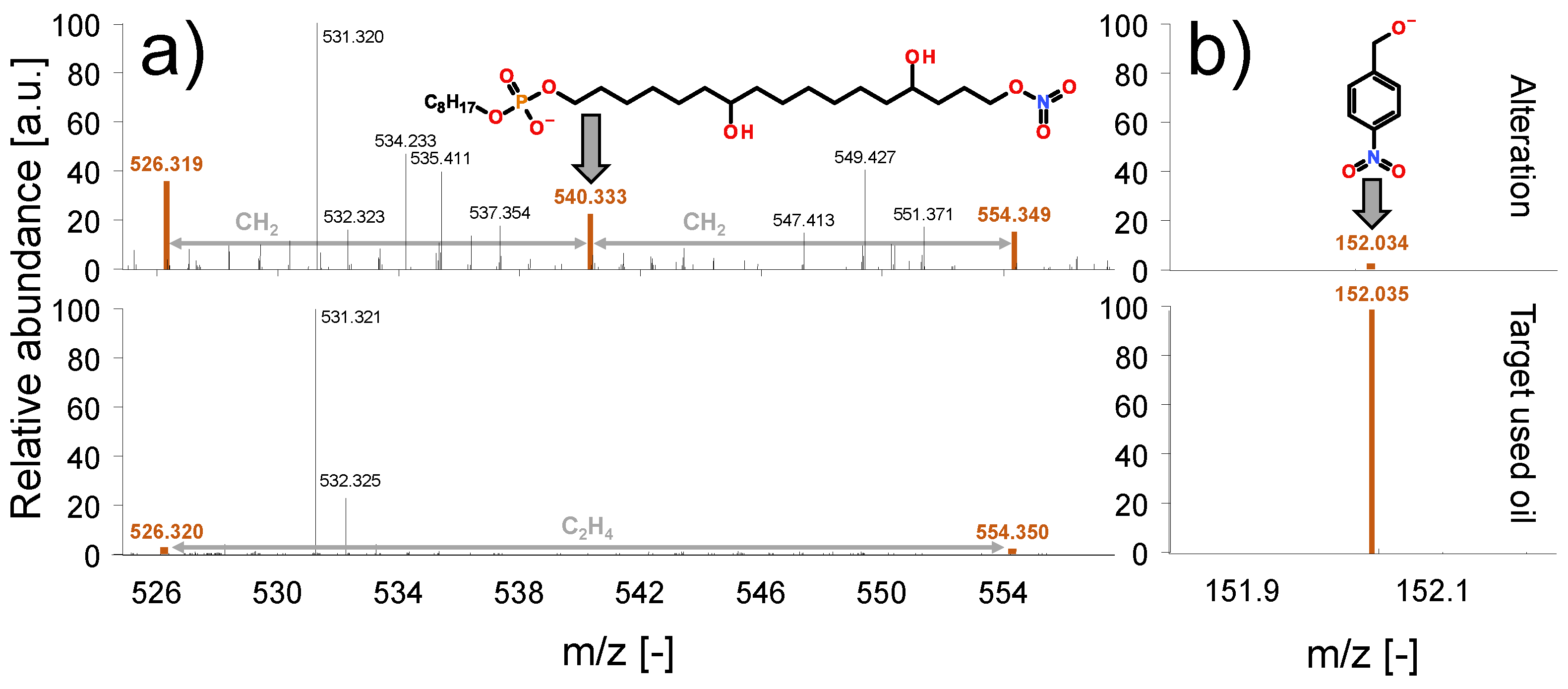
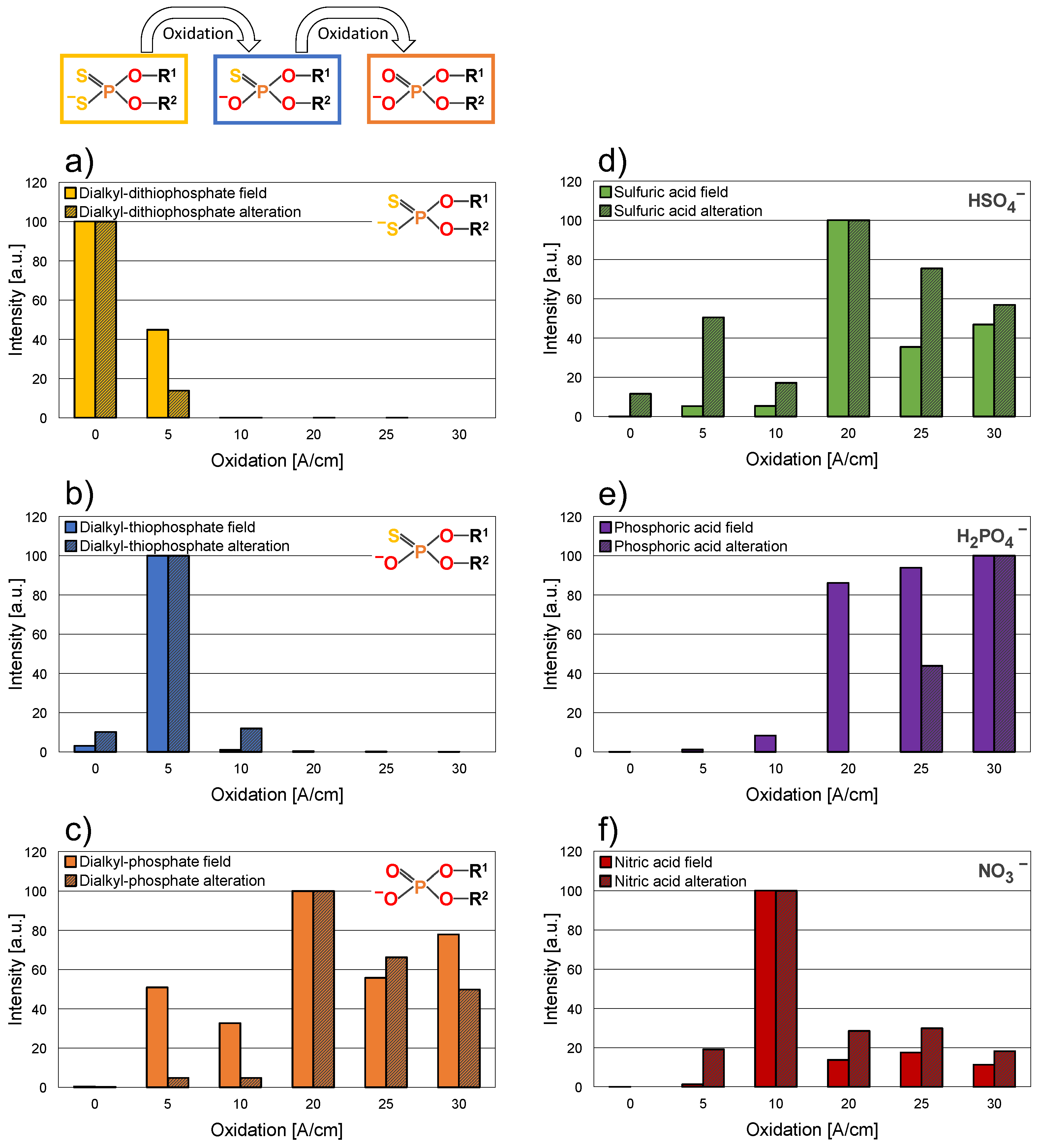
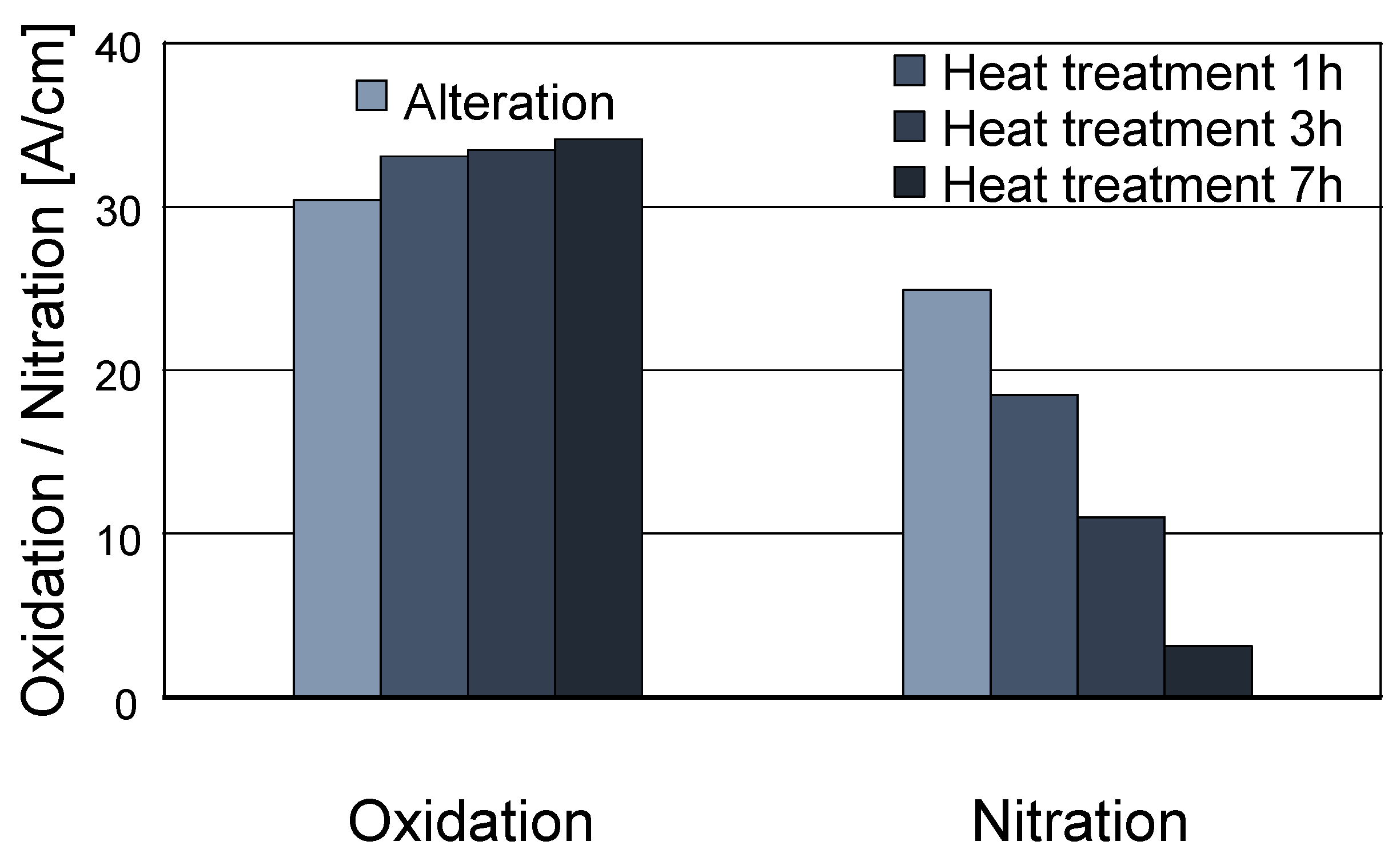
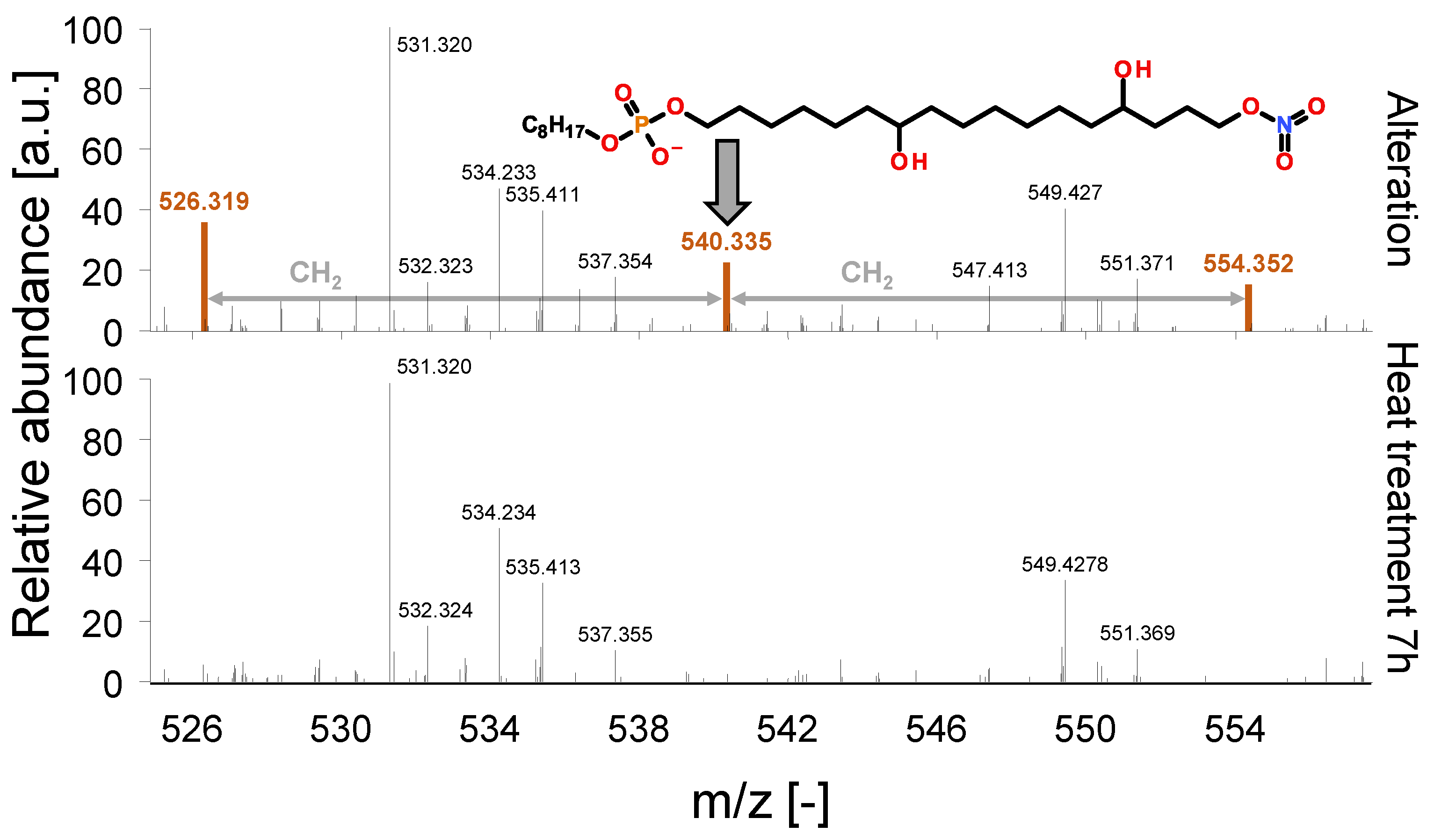
| Parameter | Value |
|---|---|
| Engine oil type | SAE 5W-30 |
| Viscosity at 40 °C (mm2/s) | 73.2 |
| Viscosity at 100 °C (mm2/s) | 12.1 |
| Viscosity index (-) | 163 |
| Density at 15 °C (g/cm3) | 0.85 |
| Total base number (mg KOH/g) | 7.2 |
| Neutralisation number (mg KOH/g) | 1.4 |
| Ca content (mg/kg) | 2200 |
| P content (mg/kg) | 770 |
| S content (mg/kg) | 3300 |
| Zn content (mg/kg) | 810 |
| Oil Parameter | Method | Measuring Principle and/or Instrument |
|---|---|---|
| Oxidation | In-house method presented in [10] | Fourier transform infrared spectroscopy (FT-IR) with a Bruker Tensor 27 (Bruker Optics GmbH & Co. KG, Ettlingen, Germany) |
| Nitration | DIN 51453 [17] | Fourier transform infrared spectroscopy (FT-IR) with a Bruker Tensor 27 (Bruker Optics GmbH & Co. KG, Ettlingen, Germany) |
| Residual antioxidant (AO) content | In-house method presented in [10] | Fourier transform infrared spectroscopy (FT-IR) with a Bruker Tensor 27 (Bruker Optics GmbH & Co. KG, Ettlingen, Germany) |
| Residual antiwear additive content | In-house method presented in [10] | Fourier transform infrared spectroscopy (FT-IR) with a Bruker Tensor 27 (Bruker Optics GmbH & Co. KG, Ettlingen, Germany) |
| Neutralisation number (NN) | DIN ISO 6618 [29] | Colour-indicator titration |
| Total base number (TBN) | DIN ISO 3771 [30] | Potentiometric titration with a Metrohm 794 Basic Titrino (Metrohm AG, Herisau, Switzerland) |
| Viscosity at 40 °C and 100 °C | ASTM D 7042 [31] | SVM 3000 Stabinger viscometer (Anton Paar GmbH, Graz, Austria) |
| Density at 15 °C | ASTM D 7042 [31] | SVM 3000 Stabinger viscometer (Anton Paar GmbH, Graz, Austria) |
| Viscosity index (VI) | ASTM D 2270 [32] | Calculation |
| Elemental content | In-house method after microwave digestion with nitric acid | Optical emission spectroscopy with inductively coupled plasma (ICP-OES) (iCAP 7400 ICP-OES Duo, Thermo Fisher, Waltham, MA, USA) |
| Target Used Oil 20.000 km on-Road Usage | Final Altered Sample 470 h Artificial Alteration | |
|---|---|---|
| Oxidation (A/cm) | 30.2 | 30.4 |
| Nitration (A/cm) | 26.3 | 29.1 |
| Residual ZDDP (%) | 6.5 | 4.5 |
| Residual phenol AO (%) | 11.1 | 18.3 |
| Residual amine AO (%) | 7.5 | 14.3 |
| NN (mg KOH/g) | 5.6 | 5.2 |
| TBN (mg KOH/g) | 3.1 | 2.2 |
| Viscosity 40 °C (mm2/s) | 71.8 | 64.2 |
| Viscosity 100 °C (mm2/s) | 12.2 | 10.4 |
| Viscosity index (-) | 168 | 150 |
| Density at 15 °C (g/cm3) | 0.871 | 0.859 |
| Ca content (mg/kg) | 2010 | 2200 |
| P content (mg/kg) | 700 | 740 |
| S content (mg/kg) 1 | 2110 1 | 3360 1 |
| Zn content (mg/kg) | 870 | 850 |
Publisher’s Note: MDPI stays neutral with regard to jurisdictional claims in published maps and institutional affiliations. |
© 2022 by the authors. Licensee MDPI, Basel, Switzerland. This article is an open access article distributed under the terms and conditions of the Creative Commons Attribution (CC BY) license (https://creativecommons.org/licenses/by/4.0/).
Share and Cite
Besser, C.; Agocs, A.; Ristic, A.; Frauscher, M. Implementation of Nitration Processes in Artificial Ageing for Closer-to-Reality Simulation of Engine Oil Degradation. Lubricants 2022, 10, 298. https://doi.org/10.3390/lubricants10110298
Besser C, Agocs A, Ristic A, Frauscher M. Implementation of Nitration Processes in Artificial Ageing for Closer-to-Reality Simulation of Engine Oil Degradation. Lubricants. 2022; 10(11):298. https://doi.org/10.3390/lubricants10110298
Chicago/Turabian StyleBesser, Charlotte, Adam Agocs, Andjelka Ristic, and Marcella Frauscher. 2022. "Implementation of Nitration Processes in Artificial Ageing for Closer-to-Reality Simulation of Engine Oil Degradation" Lubricants 10, no. 11: 298. https://doi.org/10.3390/lubricants10110298
APA StyleBesser, C., Agocs, A., Ristic, A., & Frauscher, M. (2022). Implementation of Nitration Processes in Artificial Ageing for Closer-to-Reality Simulation of Engine Oil Degradation. Lubricants, 10(11), 298. https://doi.org/10.3390/lubricants10110298






